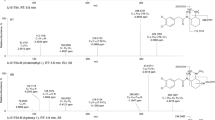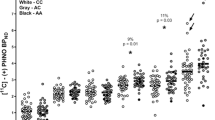Abstract
IN 1962, Friedhoff and Van Winkle reported the detection of 3,4-dimethoxyphenethylamine (DMPEA) in the urine of schizophrenic patients but not in that of normal individuals1. Attempts to confirm these findings have led to conflicting results. Two independent groups have verified that DMPEA is indeed produced by a high percentage of mental patients2,3, but another has also found it in the urine of control subjects as well4; yet others have been unable to detect it in either5,6. A recent report7 has presented a convincing correlation between the appearance of the “pink spot” equated with urinary DMPEA. and the diagnosis of schizophrenia. The interest in this specific base stems both from its close structural kinship to mescaline, a well established psychotogen, and from its implication in the metabolic chemistry of the endogenous catecholamines. 3,4 -Dihydroxyphenethylamine (dopamine) serves, in normal metabolism, as the precursor of noradrenaline and epinephrine, but it has been argued that an abnormal methylation might occur preferentially in psychotics. This specific conversion, yielding DMPEA, has been shown in vivo2,8. Alteration of dopamine metabolism has been observed in schizophrenic patients9 and this has been associated with abnormal transmethylation10. An important question has not been answered; is DMPEA a psychotomimetic agent in normal human subjects?
This is a preview of subscription content, access via your institution
Access options
Subscribe to this journal
Receive 51 print issues and online access
$199.00 per year
only $3.90 per issue
Buy this article
- Purchase on Springer Link
- Instant access to full article PDF
Prices may be subject to local taxes which are calculated during checkout
Similar content being viewed by others
References
Friedhoff, A. J., and Van Winkle, E., Nature, 194, 897 (1962); J. Nerv. Ment. Dis., 135, 550 (1962).
Kuehl, F. A., Hichens, M., Ormond, R. E., Meisinger, M. A. P., Gale, P. H., Cirillo, V. J., and Brink, N. G., Nature, 203, 154 (1964).
Sen, N. P., and McGeer, P. L., Biochem. Biophys. Res. Commun., 14, 227 (1964).
Takesada, M., Kakimoto, Y., Sano, I., and Kaneko, Z., Nature, 199, 203 (1963).
Perry, T. L., Hansen, S., and Macintyre, L., Nature, 202, 519 (1964).
Faurbye, A., and Pind, K., Acta Psychiat. Scand., 40, 240 (1964).
Bourdillon, R. E., Clarke, C. A., Ridges, A. P., Sheppard, P. M., Harper, P., and Leslie, S. A., Nature, 208, 453 (1965).
Friedhoff, A. J., and Van Winkle, E., Nature, 199, 1271 (1963).
Pscheidt, G. R., Berlet, H. H., Bull, C., Spaide, J., and Himwich, H. E., J. Psychiat. Res., 2, 163 (1964).
Friedhoff, A. J., and Van Winkle, E., Amer. J. Psychiat., 121, 1054 (1965).
Author information
Authors and Affiliations
Rights and permissions
About this article
Cite this article
SHULGIN, A., SARGENT, T. & NARANJO, C. Role of 3,4-Dimethoxyphenethylamine in Schizophrenia. Nature 212, 1606–1607 (1966). https://doi.org/10.1038/2121606a0
Published:
Issue Date:
DOI: https://doi.org/10.1038/2121606a0
This article is cited by
-
The effects of 2,5-dimethoxy-4-methylamphetamine (DOM), 2,5-dimethoxy-4-ethylamphetamine (DOET), d-amphetamine, and cocaine in rats trained with mescaline as a discriminative stimulus
Psychopharmacologia (1975)
-
Biochemical Research in Schizophrenia
Nature (1971)
-
Structure–Activity Relationships of One-Ring Psychotomimetics
Nature (1969)
-
Identification of 3,4-Dimethoxyphenethylamine from Schizophrenic Urine by Mass Spectrometry
Nature (1967)
-
Urinary Excretion of 3,4-Dimethoxyphenylethylamine in Parkinson's Disease
Nature (1967)
Comments
By submitting a comment you agree to abide by our Terms and Community Guidelines. If you find something abusive or that does not comply with our terms or guidelines please flag it as inappropriate.



